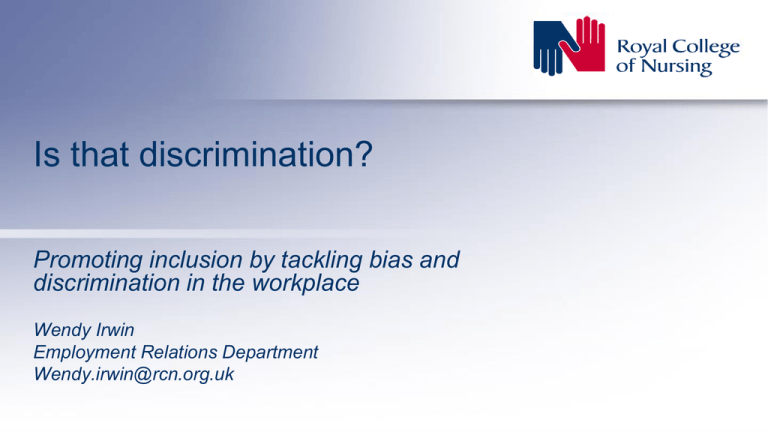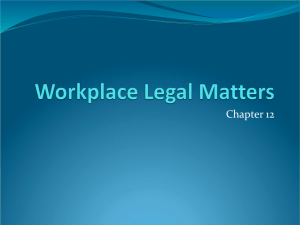Building Better Partnerships through
advertisement

Is that discrimination? Promoting inclusion by tackling bias and discrimination in the workplace Wendy Irwin Employment Relations Department Wendy.irwin@rcn.org.uk Changing the conversation about workplace discrimination Avoidance to constructive dialogue (openness) Uncertainty to safety (condition) Problem to outcome (purpose) Aspiration to demonstrable competency (congruence between values and actions) Is That Discrimination? Expanding Capacity phase one Enhancing Performance phase two Raising Awareness Phase three Phase one: Enhancing capacity Phase one focuses on building the capacity of RCN caseworkers. The outcome is to strengthen the ability of RCN accredited representatives and officers to identify and challenge workplace discrimination. Key project outputs: “ I spoke to many people about my situation and no-one saw the discrimination because it wasn’t obvious. None of that built my confidence or trust in sorting the problem out.” Enhanced training and learning offer around equalities issues built into existing provisions using a number of platforms. Provision and mastery of tools (eg,WRES and EDSII) and techniques to ensure that partnership arrangements are orientated to demonstrate leadership in tackling workplace discrimination. Phase two: Enhancing performance Phase two aims to influence employer behaviour into adopting and shaping good practice through effective partnership working. It aims to celebrate and share what works well in reducing discrimination at work. It also aims to find ways to work in partnership with those organisations who need more support to improve their performance. Key project outputs: Definitive examples of good practice with detail about to adopt and adapt across to a wide of organisational contents Tell us what you think: What does good practice in terms of eliminating workplace discrimination look like? Are there any work place equality heroes and heroines that are making a difference?. “ The reality is you talk to the union when things aren’t going well. What more could be done to stop it from going wrong at work in the first place?” Phase three: Raising awareness This phase focuses on raising member awareness and understanding of what discrimination is and their routes to accessing appropriate solutions in the workplace. Key project outputs: “ All I know is what it felt like, powerless and disbelieving that it could happen to me...I wasn’t sure how to describe it at first but you definitely know when something isn't right.” Resources in print, online and mobile. What this might mean for us? Say: Think: Do: Create an open dialogue about the nature of bias and discrimination in the workplace from its obvious and overt forms to its covert, subtle and seemingly unconscious forms. Be curious about what really works in terms of extending learning and development around understanding, identifying and responding to workplace discrimination. Challenge, inspire, encourage and observe what works in changing behaviour as well as hearts and minds. Sustaining the relationship What is working well around delivering workplace inclusion? What’s your recipe? What did you do when things didn’t go to plan? What are the personal as well as financial, human and physical resources needed? What were the lessons learned? What are the lessons that can be shared with others? Framing great practice Repository of great practice Recorded interviews with stakeholders Authentic and honest dialogue about what and why something works Ability to adapt examples to a different organisational contexts




